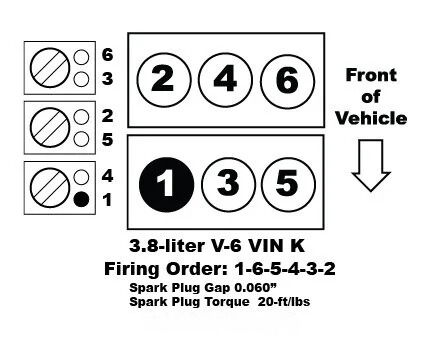The 3800 Series 3 engine, part of General Motors legendary 3.8L V6 lineup, is celebrated for its reliability, durability, and performance. It was used in various GM vehicles, including the Buick LaCrosse, Pontiac Grand Prix, and Chevrolet Impala.
A critical component of this engine’s operation is its firing order, which ensures that the cylinders fire in the correct sequence for optimal performance.
In this article, we’ll discuss the firing order of the 3800 Series 3 engine, why it matters, and how it contributes to the engine’s functionality. This guide will provide all the essential information, whether you’re maintaining, troubleshooting, or simply learning more about this engine.

Quick Navigation
The 3800 Series 3 Firing Order
The firing order for the 3800 Series 3 engine is: 1-6-5-4-3-2

How the Firing Order Works
- Cylinder 1 Fires First: The ignition starts with the frontmost cylinder on Bank 1.
- Cylinder 6 Fires Next: The rearmost cylinder on Bank 2 fires second.
- Cylinder 5 Fires Third: The rearmost cylinder on Bank 1 follows.
- Cylinder 4 Fires Fourth: The second cylinder on Bank 2 fires next.
- Cylinder 3 Fires Fifth: The middle cylinder on Bank 1 fires next.
- Cylinder 2 Fires Last: The second cylinder on Bank 2 completes the cycle.
This sequence alternates combustion events between the two banks, ensuring balanced operation and smooth power delivery.
What Is a Firing Order?
The firing order refers to the specific sequence in which the engine’s spark plugs ignite the air-fuel mixture in the cylinders. These controlled ignitions generate the power needed to run the engine. The firing order is carefully designed to balance performance, minimize vibrations, and optimize efficiency.
Why Is the Firing Order Important?
- Smooth Operation: A balanced firing sequence minimizes vibrations, leading to a smoother-running engine.
- Performance: Proper ignition timing ensures consistent power delivery.
- Efficiency: Complete combustion improves fuel economy and reduces emissions.
- Durability: Balanced combustion reduces stress on engine components, prolonging their lifespan.
Overview of the 3800 Series 3 Engine
The 3800 Series 3 is a 3.8L V6 engine introduced in the early 2000s as the final iteration of the 3800 engine family. It included enhancements like an electronic throttle control (ETC) and a more advanced ignition system, improving performance and reliability.
Engine Configuration
- V6 Layout: Six cylinders arranged in a 90-degree V-shape.
- Sequential Port Fuel Injection (SPFI): Ensures precise fuel delivery to each cylinder.
- Cylinder Numbering:
- Bank 1: Cylinders 1, 3, and 5 (closest to the radiator).
- Bank 2: Cylinders 2, 4, and 6 (closest to the firewall).
Why GM Chose the 1-6-5-4-3-2 Firing Order
The 1-6-5-4-3-2 firing order was specifically designed to suit the 3800 Series 3 engine’s V6 configuration. Here’s why it works:
- Balance: Alternating ignition between banks reduces stress on the crankshaft and minimizes vibrations.
- Power Consistency: The sequence ensures continuous power generation, preventing gaps or lags during operation.
- Efficiency: Proper sequencing optimizes airflow, combustion, and fuel economy.
- Longevity: Balanced forces reduce wear on internal components, contributing to the engine’s durability.
Identifying the Firing Order
Understanding how to verify the firing order is essential for diagnosing and fixing engine issues. Here are ways to identify the firing order in the 3800 Series 3 engine:
Check the Owner’s Manual
The owner’s manual provides detailed engine specifications, including the firing order and cylinder numbering.
Look for Cylinder Markings
Cylinder numbers are often stamped on or near the ignition coils or intake manifold for easy identification.
Use a Repair Manual
Professional repair manuals include diagrams and step-by-step instructions for understanding the firing order and ignition system layout.
Symptoms of Incorrect Firing Order
An incorrect firing order can cause several performance issues that may affect your driving experience and vehicle reliability. Here are the most common symptoms:
Common Symptoms
- Engine Misfires: Irregular firing disrupts combustion, leading to rough performance.
- Rough Idling: The engine vibrates excessively or feels unstable when idle.
- Power Loss: The vehicle struggles to accelerate or maintain speed.
- Unusual Noises: Knocking, pinging, or backfiring sounds may indicate timing issues.
- Increased Fuel Consumption: Inefficient combustion leads to higher fuel usage and emissions.
Causes of Incorrect Firing Order
- Misconnected Ignition Wires: Spark plug wires attached to the wrong cylinders disrupt the firing sequence.
- Faulty Ignition Components: Damaged spark plugs, ignition coils, or crankshaft sensors can interfere with proper timing.
- Timing Chain or Gear Issues: Misalignment in the timing system can throw off the ignition sequence.
Diagnosing and Fixing Firing Order Problems
If you suspect a problem with the firing order in your 3800 Series 3 engine, follow these steps to diagnose and fix it:
Diagnostic Steps
- Inspect Ignition Wires: Check that each spark plug wire is connected to the correct cylinder according to the 1-6-5-4-3-2 firing order.
- Examine Ignition Coils: Look for wear, corrosion, or damage on the ignition coils.
- Check Timing: Use a timing light to verify that the timing system is properly aligned.
- Scan for Error Codes: Use an OBD-II scanner to identify any misfire-related trouble codes.
Fixing Common Issues
- Reconnect Ignition Wires: Ensure the wires are routed to their respective cylinders in the correct order.
- Replace Faulty Components: Install new spark plugs, ignition coils, or crankshaft sensors as needed.
- Adjust Timing: If the timing chain or gear is misaligned, realign it to factory specifications.
Preventative Maintenance for Firing Order Reliability
To avoid issues with the firing order and ensure your engine operates smoothly, follow these preventative maintenance tips:
Regular Inspections
- Check the condition of spark plugs, ignition wires, and ignition coils during routine maintenance.
- Look for signs of corrosion, wear, or loose connections.
Replace Components as Needed
- Replace spark plugs and ignition wires at the intervals recommended by GM.
- Use high-quality OEM components to maintain reliability and compatibility.
Maintain the Timing System
- Inspect the timing chain or gears regularly for wear, especially on high-mileage engines.
- Follow GM’s maintenance schedule for timing system checks and replacements.
Engines with Similar Firing Orders
FAQs About the 3800 Series 3 Firing Order
Can I Change the Firing Order?
No, the firing order is determined by the engine’s design and crankshaft configuration. Altering it would require major engine modifications.
What Happens If the Firing Order Is Incorrect?
An incorrect firing order can cause engine misfires, rough idling, power loss, and potential damage to internal components.
How Can I Verify the Firing Order?
Refer to the owner’s manual or a service manual. You can also use diagnostic tools and cylinder markings to confirm proper ignition timing.
Is the Firing Order the Same for All V6 Engines?
No, while many V6 engines use similar firing orders, specific configurations can vary based on the manufacturer and engine design.
Conclusion
The 1-6-5-4-3-2 firing order is vital to the 3800 Series 3 engine. It ensures smooth operation, balanced power delivery, and efficient combustion. By understanding and maintaining this firing order, you can keep your engine running reliably for years to come.
Knowing the firing order is essential whether you’re performing routine maintenance, diagnosing issues, or learning more about your engine. With proper care and attention, the 3800 Series 3 engine will continue to deliver the dependable performance it’s known for, making it a trusted choice among GM vehicles.

